How to Make Half a Cake Mix
Whether you’re looking to bake a smaller cake in your toaster oven or just don’t want to deal with lots of tempting leftovers, making half a cake mix is a great option. From pan choices to dividing eggs and substitutions, we’ll walk you step-by-step through how to split a cake mix in half.
Need ideas to use up the remaining cake mix? Enjoy some Small Batch Cake Mix Cookies, Blueberry Coffee Cake, 3-Ingredient Chocolate Muffins, or treat yourself to a pair of teeny-tiny Cake Mix Mini Cakes For Two!
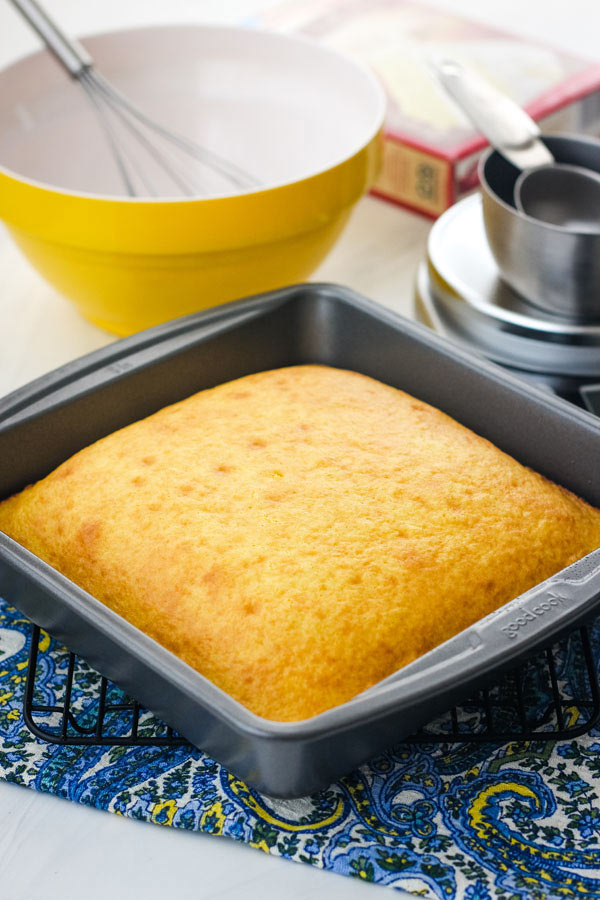
While we’re big fans of from-scratch cookies, cupcakes, and muffins sometimes it’s nice to grab a boxed mix and throw together an easy treat.
The problem is that a standard (15.25 oz) cake mix can leave you with lots of leftover cake, especially if you’re cooking for just one or two people.
Dividing the mix seems like a great solution but it can lead to lots of questions. Like how do you divide an egg, what size pan should I use, does it need to bake for the same amount of time?
Below, we’ll answer all of those questions and more!
At over 2,500 words, this post ended up being a little longer than we expected (I blame all the egg attempts). So we put together a table of contents for you.
If you want to skip ahead, click on the part you’re interested in and you’ll be taken right to it.
Table of Contents
- Splitting The Mix in Half
- Divide The Water and Oil In Half
- Halving Eggs + Substitutions
- New! We Tried Some Vegan Egg Alternatives
- Choosing Your Pan
- Oven vs. Toaster Oven vs. Convection Temperature
- Mix and Bake
Step1: Divide The Cake Mix In Half
The ingredients in your boxed cake mix have been sitting and settling for a bit on that grocery store shelf. Before you get started, grab the bag and give it a quick shake to mix everything up.
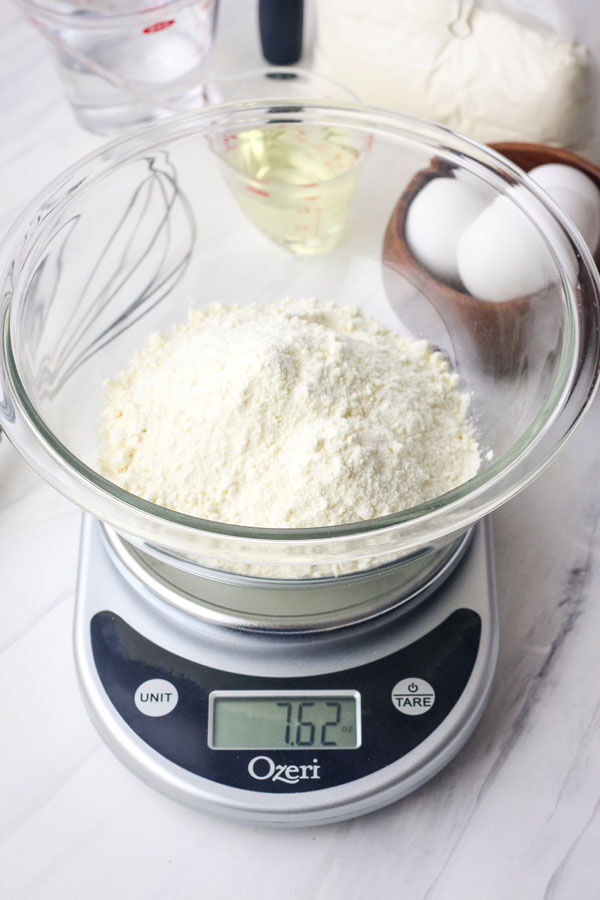
Now, you could try to dump half the bag out but dividing the mix into equal portions will yield the best results. Here are two ways to go about it.
Option 1: Using a Scale
A standard boxed cake mix (in the US) weighs 15.25 ounces. So half a box of cake mix weighs 7.625 ounces.
To measure out half, place a medium bowl on your scale and zero it out. Pour the mix into the bowl until it measures 7.62 ounces.
Option 2: Using Measuring Cups
A cake mix that weighs 15.25 ounces has 3⅓ cups of mix total. So half a box of standard cake mix is 1⅔ cups.
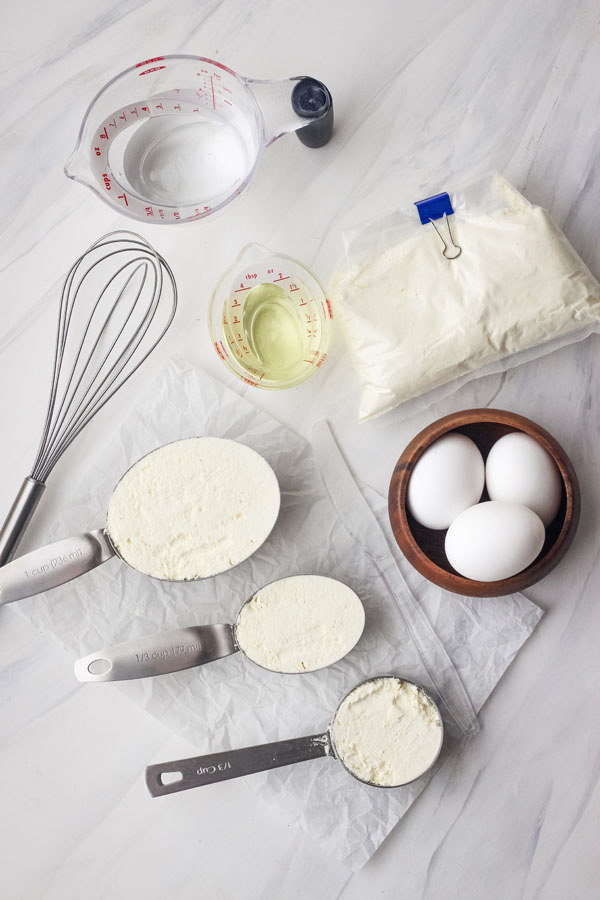
To measure out half, use the spoon-and-sweep method. This method will keep you from compacting the mix and taking more than half.
- Place a piece of parchment paper on your counter.
- Spoon the mix into a dry measuring cup and use the back of a knife to level off the mix.
- Repeat until you have 1⅔ cups of mix measured out.
- If you have any of the dry mix on the parchment paper, pour it back into the bag with the other half of the cake mix.
Did that sound confusing? If it did, check out this post by Sugar Spun Run on How To Properly Measure Flour.
Okay, now that you’ve got your mix divided let’s look at the other ingredients.
Step 2: Divide The Water and Oil In Half
Take the amount of water called for and divide it in half. So, if the box instructions call for 1 cup of water use 1/2 cup.
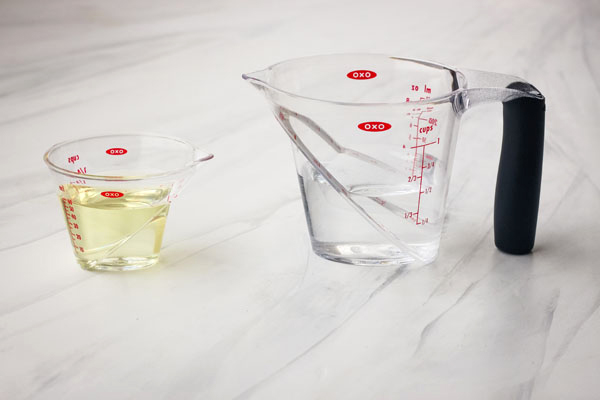
When it comes to the oil, some boxed cake mixes (like Betty Crocker and Pillsbury) call for 1/2 cup of oil while others (like Duncan Hines) use 1/3 cup.
Take whatever the instructions on your box call for and divide it in half.
- Half of 1/2 cup = 1/4 cup or 4 tablespoons
- Half of 1/3 cup = 2 tablespoons + 2 teaspoons
I usually make our cake mix with olive oil or avocado oil but you can use any vegetable oil you want.
If you use coconut oil (in a liquid state), just make sure the other ingredients are at room temperature (and not cold). Otherwise, the coconut oil will harden into lumps and muck up your batter – it will be sad.
Step 3: Halve The Eggs + Substitutions
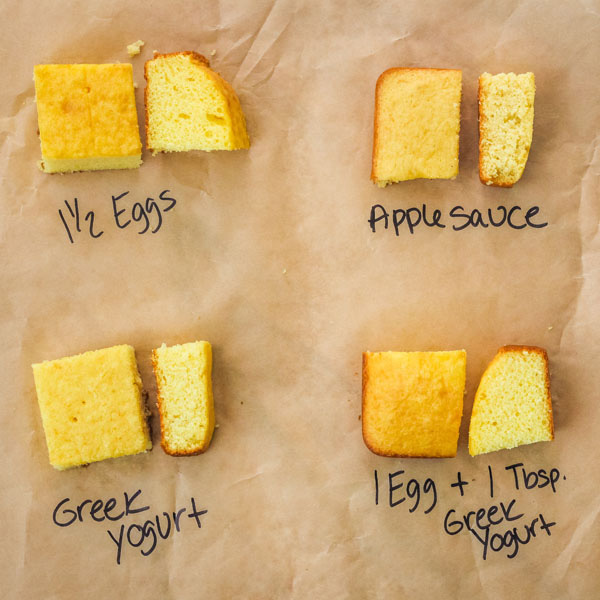
If the box calls for 2 eggs, just use one egg.
But what if it calls for 3 eggs?
The Quick Answer: Use one whole egg + half a beaten egg.
To measure out the beaten egg, crack an egg into a small bowl and beat with a fork until the white and yolk are combined. Measure out half, about 1½ to 2 tablespoons (give or take a little). For more tips check out this How to Measure Half an Egg post.
*You’ll want to refrigerate the remaining beaten egg and use it within 24 hours.
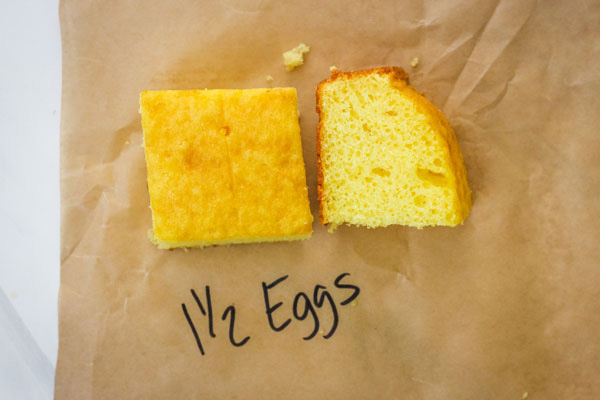
The cake we made using this method turned out great. It was moist with a nice flavor and light texture. Just what you’d expect from a cake mix.
BUT…that leftover beaten egg was a little inconvenient and potentially wasteful. So we wanted to see if it could be avoided.
We grabbed more lemon cake mix, divided the boxes up and tried out some substitutions.
Applesauce
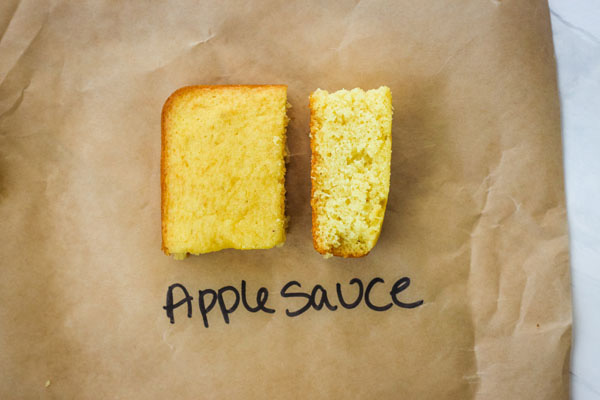
First, we replaced all of the eggs with 1/4 cup of unsweetened applesauce. (Spoiler: don’t do this – it’s not a great option).
The Results: The cake barely rose, was lacking in flavor and when I tried to cut it after cooling, it cracked and fell apart.
Would We Do It Again? Nope.
Greek Yogurt
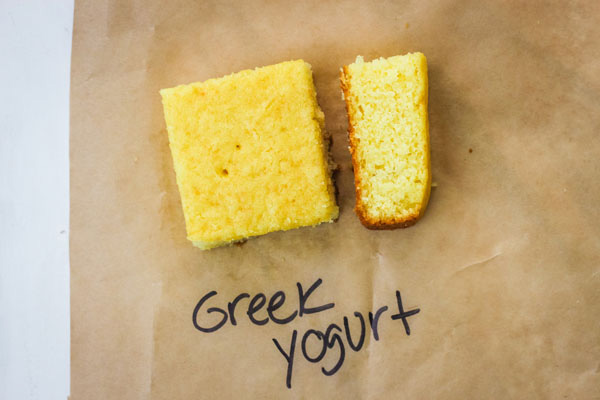
Another option is to replace all of the eggs with 2 tablespoons of plain yogurt, regular or Greek variety.
The Results: The cake didn’t rise much but it did hold together well and tasted great. The crumb was denser but not in a bad way.
Would We Use This Substitution Again? Yep. I think the pound cake-style texture would be perfect for pairing with whipped cream and berries, especially for a summer brunch or Mother’s Day treat.
Egg + Greek Yogurt
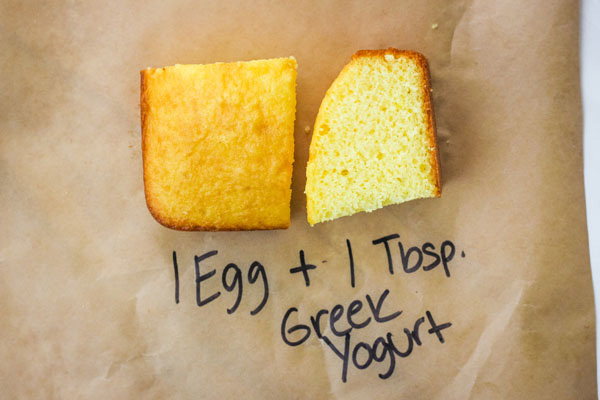
The last option we tried was using one egg plus a tablespoon of yogurt.
The Results: This cake was tender, had a nice flavor and was lighter than the all-yogurt option. While it did crumble some, it didn’t fall apart like the applesauce one.
Would We Use This Substitution Again? 100% Yes! Overall it had a great flavor and nice texture. Plus it was so easy to grab a spoonful of yogurt and add it in with the 1 egg.
What about using 1 whole egg + part of another egg?
A lot of small-batch baking recipes call for a single egg white or a single egg yolk (like our rich and fudgy toaster oven chocolate cookies). Leaving you with some part of an egg to use up.
To see if an extra egg yolk or an egg white would make a good addition to half a cake mix we grabbed a box of the same lemon cake mix from before and got baking.
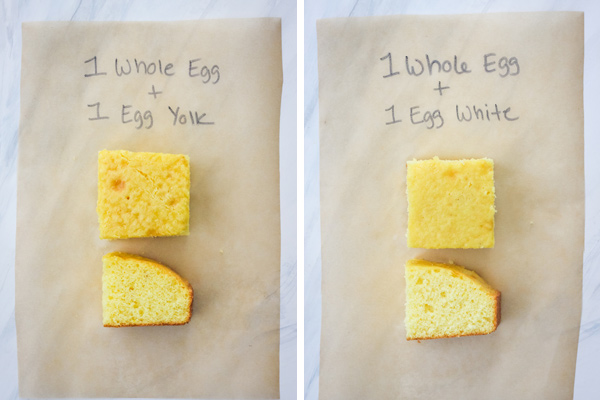
The first option we tried was one large egg plus an egg yolk.
The Results: While the crumb was a little heavier it was still very tender and moist. Because of the added yolk, the cake had a deeper yellow color and the extra fat did cause it to brown faster around the edges and on top.
Would We Use This Substitution Again? Absolutely! The cake’s lemon flavor really came through. It was a little denser than a traditional cake mix but not in a bad way.
The second option we tried was one large egg plus an egg white.
The Results: At first, I was a little concerned because the cake had a faint eggy smell while it was cooling. But once the cake had cooled completely and we cut into it all I could taste/smell was a nice lemon flavor. The texture was very light and bouncy.
Would We Use This Substitution Again? Definitely, the cake tasted delicious and we both really enjoyed the lighter texture.
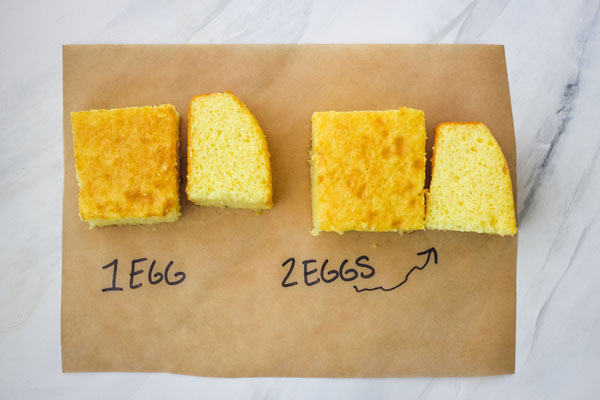
About a week after this marathon baking session we decided to try two more options. Making half a mix using only 1 egg and using 2 eggs.
The 1-Egg Results: The cake was noticeably drier than the other cakes. While it still had some structure it crumbled easily. When you took a bite, the cake would kind of fall apart in your mouth.
Would We Use This Substitution Again? Probably not. This cake was definitely better than the applesauce option, but it wasn’t something I enjoyed. Tim did say he would eat it again.
The 2-Eggs Results: This cake rose taller than any of the other cakes, was super bouncy, and almost sponge-like. I felt like I could easily carve and frost it without a lot of crumbs.
Would We Use This Substitution Again? Maybe. Tim really enjoyed this cake. I thought it was light with a nice flavor but that it could use more moisture. I might try it again, swapping the water for milk and adding a little yogurt.
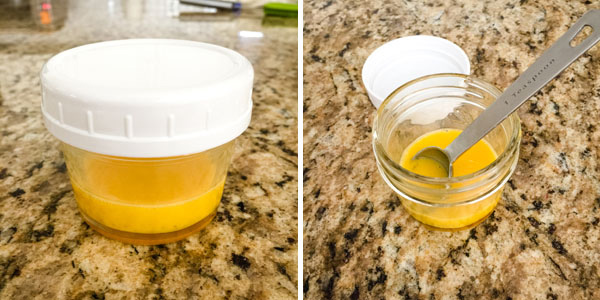
If you’re not sure which egg option is for you, it’s always a good bet to stick with 1 whole egg + half an egg.
Here are a few ideas to use up the leftover egg:
- These small-batch triple ginger cookies use 1 tablespoon of egg.
- Make a batch of chocolate chip pecan oatmeal cookies with 1½ tablespoons egg.
- Grab a frying pan, scramble the egg and add it to a sandwich or salad.
We Tried Some Vegan Egg Alternatives, Here’s How it Went
We’ve been experimenting with plant-based egg replacers recently and I thought it would be fun to see how they worked in a cake mix. So we tried making half a lemon cake mix and half a chocolate cake mix.

We used Duncan Hines cake mixes and baked each cake in an 8 x 8 pan at 350°F until a toothpick came out clean, about 18 to 20 minutes.
Substitute: Bob’s Red Mill Egg Replacer
Bob’s Red Mill Egg Replacer is a gluten-free mix of potato starch, tapioca flour, baking soda, and psyllium husk fiber. Combined with water, it can be used to substitute a whole egg, an egg white, or an egg yolk in different baking recipes.
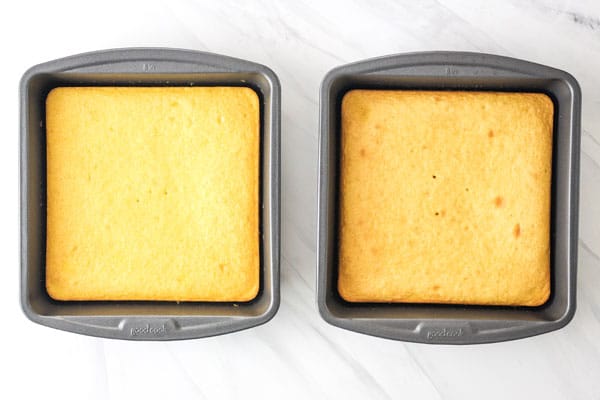
How We Used It: The package directions state that for each whole egg you want to replace, combine 1 tablespoon of the egg replacer + 2 tablespoons of water, stir, and let sit for 1 minute to thicken before adding to the recipe (or in this case, cake mix).
Since we were making half a cake mix and only needed to replace 1 whole egg plus ½ an egg we used 1½ tablespoons of the replacer combined with 3 tablespoons of water for each cake.
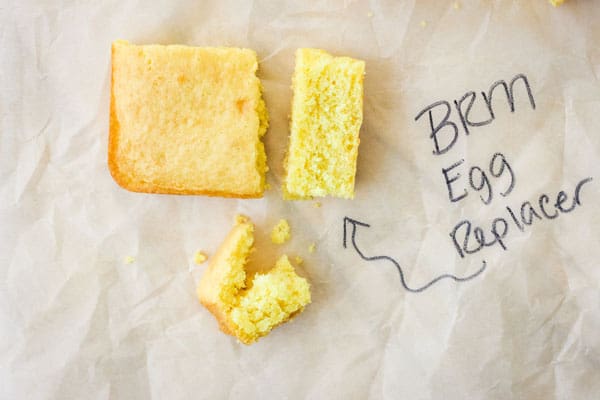
- Appearance: Both the lemon and chocolate cakes sank a little in the middle during cooling and were flatter than a traditional cake mix cake. The lemon cake had a dull color and looked more like cornbread.
- Flavor: Both the chocolate and lemon cakes had a muted flavor with a slightly chalky aftertaste.
- Texture: The cakes were delicate and crumbly, it was almost impossible to get a piece out of the pan without them cracking. Similar to the cakes made with applesauce, it kind of turned to mush in your mouth.
- Would We Use This Substitute Again: In a pinch, maybe. But if we had other options, probably not.
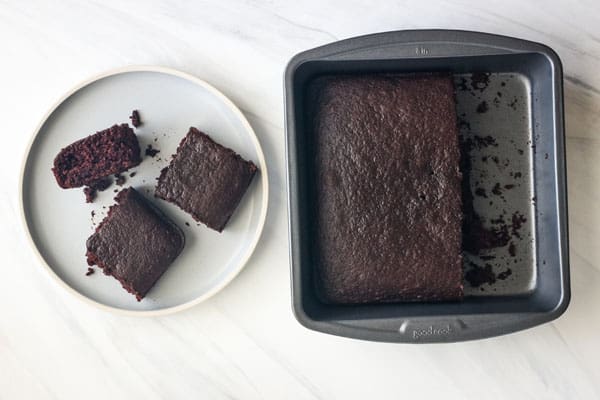
Substitute: Just Egg
Just Egg is a refrigerated plant-based egg alternative. Mung beans are the main ingredient in this pourable mixture that aims to look and taste like scrambled eggs when cooked in a frying pan. According to their website, Just Egg works in a variety of baking recipes except for light cakes and meringues.
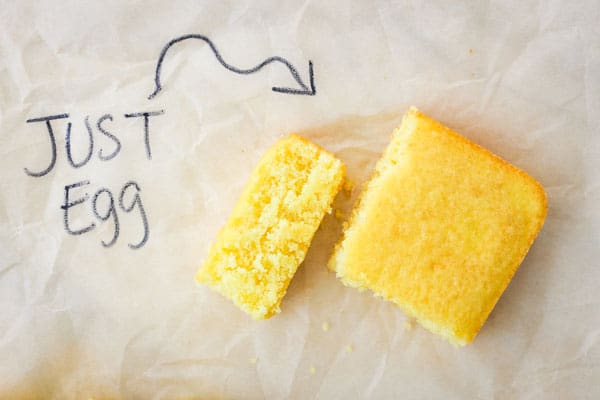
How We Used It: 3 tablespoons (44 grams) of Just Egg is the equivalent of one traditional egg. To replace 1 whole egg plus ½ an egg we used 4½ tablespoons (66 grams) of the mixture to make each cake.

- Appearance: These cakes also sank a little in the middle and didn’t rise as much. The lemon cake was a vibrant yellow while the chocolate cake had a rich fudgy appearance.
- Flavor: The chocolate cake had a great flavor – if someone served you a piece, you’d probably be surprised to find out it was made with an egg substitute. The lemon cake was a slightly different story. The lemon flavor was difficult to find (both in taste and smell), the cake was less sweet than a traditional cake mix, and had some saltiness. If you find cake mixes to be too sweet, you might enjoy this substitute.
- Texture: Both of the cakes were moist and light but had enough structure that you could remove a slice and hold it in your hand without it crumbling.
- Would We Use This Substitute Again: Yes, definitely to make a chocolate cake mix. I’m not 100% sure it’s great for other flavors but we do plan to experiment more. Especially since it made a fantastic egg substitute in our mini one banana bread recipe.
Do you have a favorite egg substitute for making cake mixes? We’d love to hear about it in the comments.
Step 4: Pick Your Pan
An 8 x 8 x 2-inch pan or an 8 or 9-inch round pan are good options for making half a cake mix.
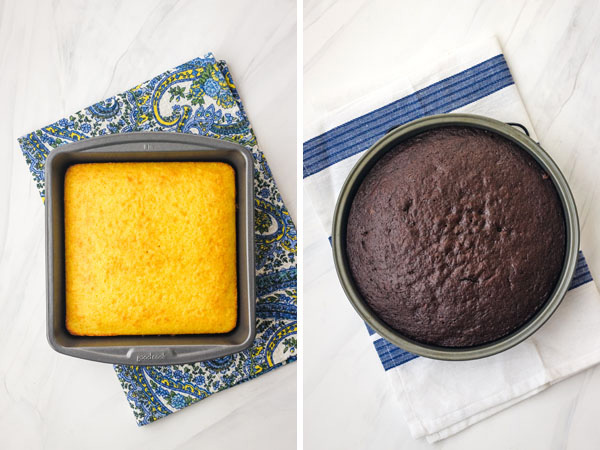
If you don’t have one of those pans we’ve got a bunch of ideas for you!
- 8 1/2 x 4 1/2 Loaf Pan
- 2 Round 6 x 2-inch Cake Pans
- 2 6-cup Muffin Pans or a 12-cup Muffin Pan
- 11 x 7-inch Cake Pan
- Quarter Sheet Pan
- 8.5 x 6.5-inch Casserole Pan
*Pro Tip: Use a plastic knife to cut the cake, it won’t scratch your metal pan.
Once you’ve got your pan sorted, make sure to grease it so your cake doesn’t stick.
Step 5: Preheat The Oven
If you’re baking with a conventional ‘big’ oven, follow the box directions for the correct temperature setting.
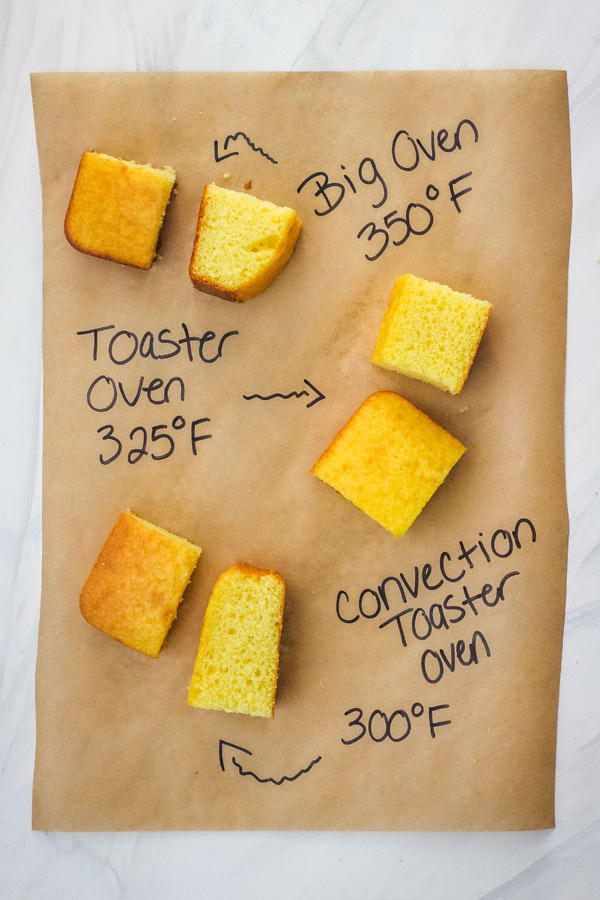
For a standard toaster oven, I find reducing the temperature by 25 degrees yields the best results.
When using the convection option on our countertop oven, I reduce the temperature by 50 degrees (making sure not to go below 300F). This helps to give the middle enough time to cook through without over-baking the edges.
*As all ovens are different, you may need to play around a bit to find the perfect temperature setting for your specific oven.
Step 6: Mix and Bake
Now that you’ve got your mix and ingredients divided, your pan selected and prepped, and your oven preheating all that’s left to do is mix up the batter and bake it.
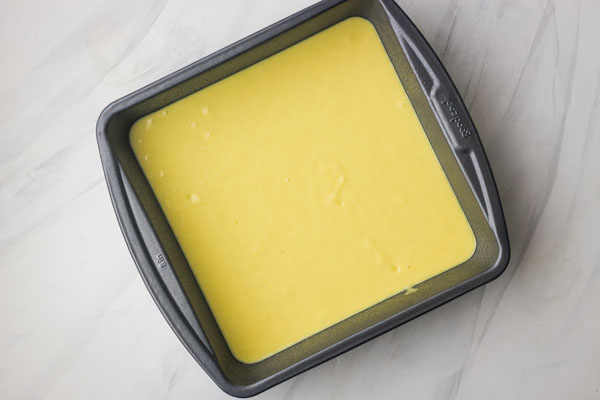
Follow the directions on your package for combining half of the mix and half of the ingredients. Then pour the batter into your prepared pan and bake according to the directions.
Check On Your Cake Early
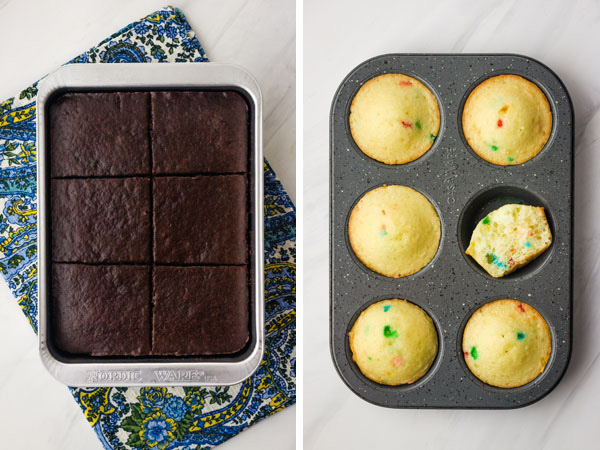
The type of mix, pan, ingredients, and oven used will affect the baking time.
- Cupcakes might take the same amount of time (ours took 15 minutes)
- Because it’s thinner, a quarter sheet pan will bake up quick (about 14 to 16 minutes)
- A loaf pan will likely take longer (about 22 to 25 minutes)
- Two round 6 x 2-inch cake pans will have a shorter baking time (about 15 to 18 minutes)
For the best results, begin checking for doneness 8 to 10 minutes earlier than the shortest baking time listed for a cake pan on your box. Then add more time as needed.
You’ll know the cake is ready when a toothpick inserted into the center comes out clean.
Wait for the cake to cool completely before digging in!
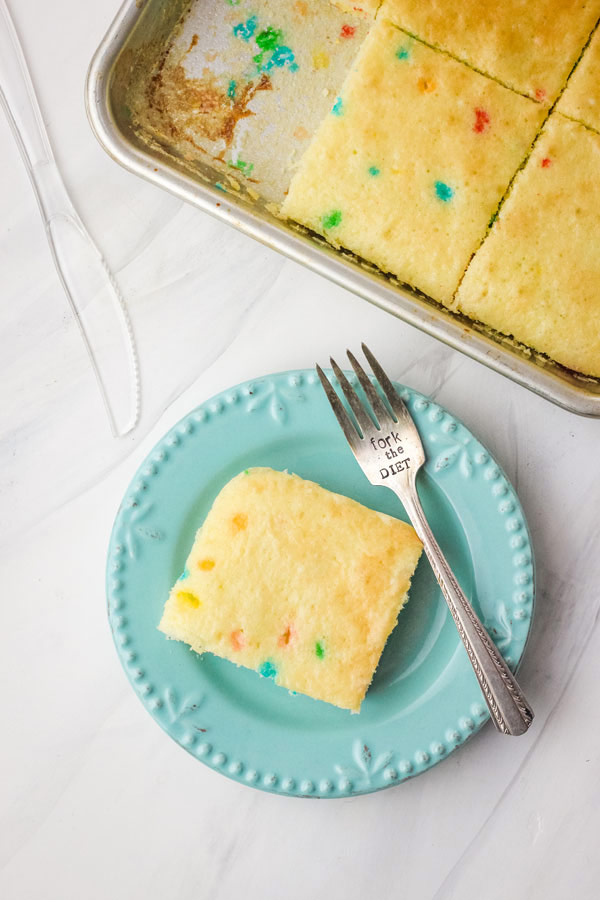
Storing The Leftover Dry Mix
I recommend putting the remaining mix in a reusable sandwich bag. That way you can toss it into the cake mix box with the directions and ingredients info.
Pro Tip: Write the baking time, temperature, and pan used to bake half of the mix on the outside of the box. That way whipping up the other half will be super easy.
If you’re looking for ways to use up that leftover cake mix, you can find all of our small batch cake mix recipes here.

I am 91 and do very little baking anymore… years back i would do what you posted. B UT now I don’t want to take the time andd still need the info so…THANK YOU THANK YOU THANK YOU..appreciate all your help which I know took a lot of time. again Thank yhou Ann
It’s our pleasure, Ann! Thanks for taking the time to stop and say hi and leaving such lovely and kind words. We hope you enjoy the cake 🙂
Happy Baking,
~ Brie
Hi! Made a 1/2 box yellow cake (Aldi brand) and added 2 eggs. It was easier to do 2 eggs instead of scrambling one and dealing with 1/2 a scrambled egg. Do not have a food scale so I just used your measurements above. Baked in a square 8×8 pan at 350 for about 30 minutes and it came out perfect. The cake gave us 9 slices and was enough for a weeknight birthday celebration for a family of 4. Thank you and will use these instructions again for a snack size cake/small cake!
~Mary
That’s fantastic to hear, Mary! Thanks for taking the time to come back to let us know how the cake turned out and what method you used. It’s good to know that the Aldi cake mix did well – we love that store 🙂
Happy Baking!
~ Brie
Just tried this with a Duncan Hines chocolate cake. Swapped the 1/2 of oil with 4-ish tablespoons of butter, used 2 eggs baked in an 8×8 pie pan (used what I had on hand) for about 20 min. Came out light, fluffy and flavorful. 🧁💕☺️
Yum! Your chocolate cake sounds delicious, Ms. Monroe. Thanks for sharing the swaps that worked for you 🙂
Just made a spice cake using the tips here. Instead of playing the egg measuring game I used one egg and one tablespoon of mayonnaise. The full recipe called for 3 eggs. The cake is perfect! So glad I found this site!
I absolutely love that because of this post, I can now bake half of a cake! It is just something that I never even thought about. Now that I know, I make half – cakes all of the time.
Thank you. Thank you. Thank you.
It’s our pleasure, Star! Wishing you many many happy bakes ahead 🙂
~ Brie
This is one of the BEST food-related posts I have ever seen! I’m an experienced cook, and the detailed information you provide is spot on and very valuable, especially for newbies. I love that you provided pictures of what the cake results are using different types of eggs/egg replacements. Some excellents tips – like cutting the cake with a plastic knife to avoid scratching the pan. It is obvious you put a lot of time and effort into this – Thanks!!
Thank you, Vera! That’s such a nice thing to hear and really means a lot 🙂
Correction on dividing mix by measuring:
If the mix equals 3 1/3 cup then half would be 1 1/2 cups (half of 3 cups) and 2 Tbsp + 2 tsp (half of 1/3 cup).
I converted to decimals because 1 2/3 cups didn’t seem correct:
1 2/3 = 1.667
3 1/3 = 3.333 ÷ 2 = 1.833
Then I used lots of measurement conversion charts…tablespoons in cups, teaspoons in tablespoons to arrive at 1 1/2 cups + 2 Tbsps + 2 tsps.
Hi Des,
We appreciate you checking our measurements as we’re not immune to mistakes 🙂 but in this instance the amounts in the article are correct. If you double-check your math, there’s a small error.
1⅔ = 1.667
3 ⅓ = 3.333 ÷ 2 = 1.665 (not 1.833)
The good news is that using cups and tablespoons you actually did still end up at 1 ⅔ cups. That’s because ⅔ cup = 10 tablespoons plus 2 teaspoons or ½ cup + 2 tablespoons + 2 teaspoons.
All of this stuff can be really confusing which is why we wrote a post to try and help. But people don’t have to do things the way we do them.
In the comments, you’ll see that others have shared lots of different approaches to dividing the mix. Some like to skip the spoon and sweep method and pack the cake mix into 1½ cups instead. LeAnn has a cool technique where she just sinches the bag in the middle.
If you’ve got a kitchen scale, it’s always going to be the most accurate way to measure the cake mix (just divide the ounces or grams in half).
But don’t sweat it too much, cake mix is usually pretty darn forgiving 🙂
Happy Baking!
Thanks for checking!
Forgot to half the 1/3 cup.
Won’t make that mistake again.
Hello! Mayonnaise is egg and oil. I often use a touch of mayo in muffins, cakes and quick breads because it makes them stay moist a bit longer. I would need to do some testing to give you exact amounts, but using one egg and some mayo could be a better solution to the apple sauce or yogurt.
Great suggestion, Caren!
I was up late one night making last-minute cupcakes (using yellow cake mix) for a thing at work, only to discover I was short by an egg. Consulting the net led me to substitute a banana, and they turned out great. Nobody realized I had used a banana until I mentioned it.
So, maybe try 1 egg + 1/2 a banana, and scarf the other half. 🙂
Thanks for the great tip, Alisha, I can’t wait to try it! And I love your suggestion for using up the leftover banana 🙂
why not use eggs that come in a carton, no waste. sounds simple enough. nes pas.
suecat
Hi Sue,
Are you talking about the eggs that are pourable and sold in a milk carton-style container? In the US those are usually just egg whites mixed with some form of stabilizer (like guar gum) and coloring to make them appear more like traditional eggs.
They’re definitely an option but will probably result in a different cake texture. I’ve never used them but if you give them a try come back and let us know how it goes!
Egg Beaters are whites only, but there are several other brands of ‘liquid eggs’, which are whole eggs, that are sold in US grocery stores. That definitely would be easier than dividing eggs. But unless you regularly use liquid eggs, you’d be left with half a carton and that’s no good.
I’m a new fan!! Wish I had found this post yesterday. About 200,000 mini cupcakes later (for a bunco gathering of which they’ll eat about 10 and I’ll be left with the rest). I also am a recent convert of the toaster oven. I’ll subscribe to your blog for sure.
Welcome to Team Toaster Oven, Mary! We’re so glad you’re here.
Thanks for subscribing and I hope you have a fantastic Bunco night! I’m sure your mini cupcakes are going to be a big hit, but I’d be happy to help with any leftovers 🙂
My kids call me a hippie cook because I always detour off recipes. I started using half cake mixes but I use a more relaxed way. I sinch the middle of the bag like a waist line and dump the top half into the mixing bowl. The rest is easy to adjust. Tonight I used 2 small eggs 2 tablespoons oil and 2 tablespoons butter, one cup shredded zucchini, and 1/2 cup chocolate chips in a chocolate cake mix. I then added milk to a thick cake mix consistency (about 1/4 cup)It was delicious. I cooked it in 4 mini Bundt cake pans and froze 2 of them.
Thanks for sharing your tips and chocolate zucchini cake recipe, it sounds super yummy 🙂
I’ve been halving cake mixes forever. I use the same method to halve countless other prepared mixes as well. The only difference is that I find the metric measurement infinitely easier to divide. Instead of using the ounce measurement in the box, I look for the grams in parenthesis beside it. Divide by two and set your kitchen scale to grams. So easy.
Regarding the eggs for cake mix I always use two (instead of 1.5) and the cakes are great.
Just finding this…thanks for the tips. I always make 2 8x8s….we have loads of elderly neighbors and relatives near by that we can share the extra cake (or pieces) with….most of them no longer bake and they really enjoy a homemade treat!!! This is great to know when I don’t have other ingredients to make the 2 cakes.
I’d like to share that if you are making cupcakes make sure you spray your liners! It makes a huge difference when you peel that paper off!
I’m off to make a cake now!! Gee thanks for setting off the craving!😂😋
Thanks for the tip, Jane!
Regarding the eggs: Most mixes call for large eggs. If you buy small eggs, then 3 large is equal to 4 small, easily divided in half.
I made half a mix a couple days ago. It’s just my husband and I, so a full size cake is just a waste. I poured all the mix out in a big bowl to see how much was in there. Then I divided it. Fractions are not my friend, but I figured it out. Of course I forgot to write the amount down. So I was really glad to find it. I do have the half a box left, but in the future, I will know how much mix to use, thank you very much. I Halved the water and oil. I did use only one egg, though. It came out great. I always add a little vanilla extract to my mixes. I used only one 6×2” round pan. I was worried the batter would come over the sides, it didn’t, but It rose extremely high. It was really moist and flavorful. Chocolate. I used Hershey’s frosting recipe. It’s the best, almost like a fudge. I baked this in my convection microwave on 350, for about 28 minutes. This was perfect for us.
That cake sounds delicious, Marsha! Love the vanilla extract tip since boxed mixes can taste a little one note, I bet it really brings out the chocolate flavor 🙂
Or you could just bake the whole cake in separate pans and put one in the freezer.
That’s a great idea too, Celia! I’m sure there are lots of people who wouldn’t mind having a little extra cake on hand 🙂
That is what I do. A full size cake is to much for my husband and me, so I cut it in half, wrap half in cling wrap, then in foil and freeze. Whenwe are ready for cake I thaw it then frost.
Cake mixes are much smaller than they used to be. 😳. They almost fit perfectly in a 9 inch round. 9 x 13 cakes are flat. ☹️
I add 1/2 cup mix from another cake mix to equal the original 18 oz mixes.
I’ve gotten into the habit of dividing my cake mixes into thirds, to avoid the problem with dividing eggs but I really like your solution. And you’ve given me an excuse to buy a food scale.
I attempted to make square cup cakes by putting two jumbo muffin liners into a small loaf pan. Not a elegant result but I hadn’t thought of the touching side interlocking, almost like a puzzle piece. I might try it again with just a divider of parchment paper.
Hi, Eva!
Thanks for taking the time to comment and share your tips. Dividing the mix into thirds is a fantastic idea – especially if you want a little less cake.
I hope you enjoy your new food scale, my favorite thing about using one is that there are so many less dishes to wash. 🙂
That mini pan cupcake hack is super smart. You might want to try using foil to create a divider, I’ve used it a few times to create a smaller baking space when my pan was too large and the foil is very strong once you’ve folded it a few times.
Happy Baking!
Brie
Thanks
I, too, divide in 1/3’s! I’ve found, most ALL commercial cake mixes, measure 3 cups, so dividing everything is a …er…ahem, “piece of cake!”! And, at those times when I want to do 1/2 instead-unless they are Costco eggs- a large egg is, barely the equivalent of a medium-and 2 mediums work just fine for us! Or, as my mama used to say “ You’d never notice on a galloping horse!” Lol!
Thank you for sharing on how to half the cake mix recipe. It’s very detailed and I appreciate you take the time to explain.
Now I can bake my favorite cake without over indulging.
I’m so glad you enjoyed the article, Eileen! Thank you for taking the time to leave a comment and I hope you have lots of fun baking your favorite cake 🙂
Thanks for the information. I always wanted to try half a box but never did. Guess I will now. Thanks for doing all the leg work! Have a nice day!
My pleasure, Carole! This experiment-style post is my favorite to research and write – I hope it ends up being helpful with your cake mix adventures 🙂
Happy Baking!
I have been halving my cake mixes for a while now and have now trouble with the ingredients. My MIL taught me to use a cake mix, add a box if instant pudding in complimentary flavor, use 4 eggs, 1 cp milk and 1/2 cup oil for a full cake. To half it is easy once you half the cake mix and the pudding mix. And the cake turns out just the same as if you made the full recipe. (Now I have to go make a cake!)
Thanks for sharing your method and tips, Melinda! Yep, I think there’s a rule that once you say cake 5 times you have to go bake one 🙂
Ready to give this a try. Am always on the look out for toaster oven recipes. Am looking forward to seeing some from you. Also appreciate your tips with this recipe.
Hi Barb!
Oooh I wish I could get a slice, cake sounds so good right now 🙂
If you hit any snags or have a question while you’re whipping it up, feel free to email or leave a comment.
Thanks for stopping by and happy baking!!
So glad I found your post! Since my hubby passed I don’t bake much because it’s just me and I have no self control what-so-ever when it comes to sweets. This is fantastic! Now I don’t have to wait until I have a gathering to make a cake. Since it’s just me (table for one!) and I use my toaster oven most of the time I will definitely use your recipes and ideas. Thank you.
Hi Joann and welcome! I’m so happy you’re here and hope you find some new recipes to enjoy.
I know what you mean about the sweets, cupcakes are my personal kryptonite 🙂 We’ve started working on a few single-serving desserts for those times when even a small-batch is too tempting.
Happy Baking!
I so look forward to your emails! I am single and hate eating leftovers for days. I do crave cake and cupcakes but don’t want to be tempted to eat and entire cake or 24 cupcakes. Thanks!
Also love all your veggies recipes as I’m eating less meat.
You’re so welcome, Karla!
Thank you for such a sweet comment, it means a lot. 🙂